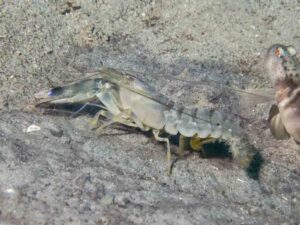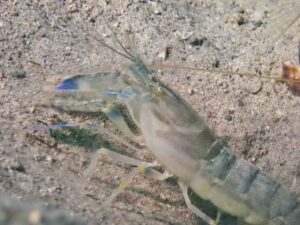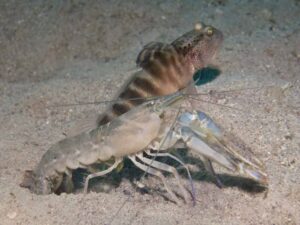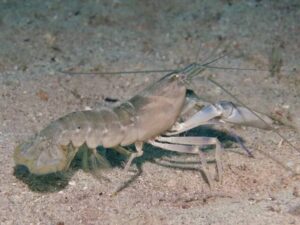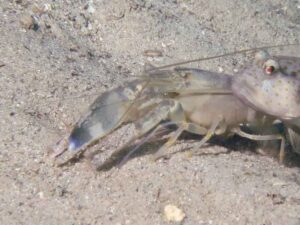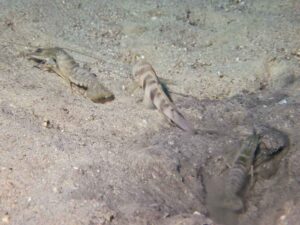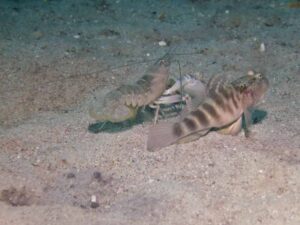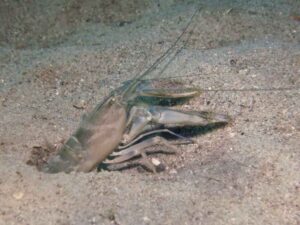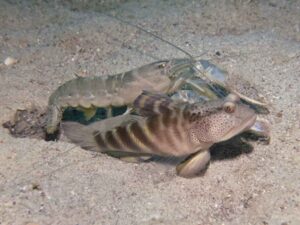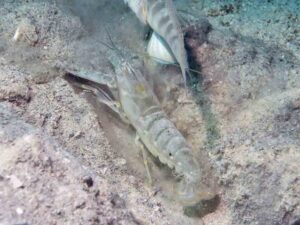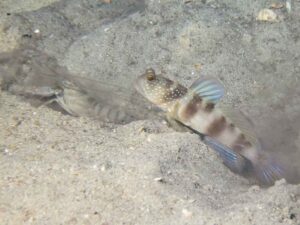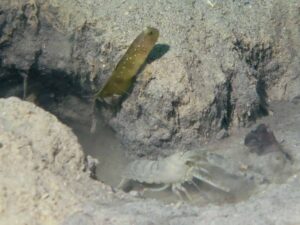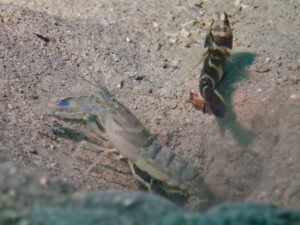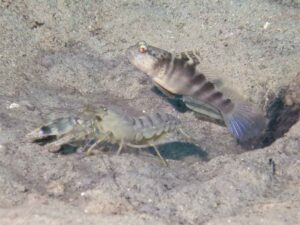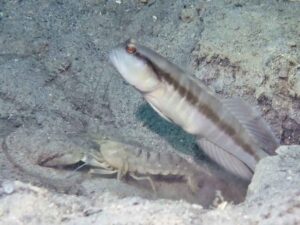Blue Nipper Snapping Shrimp
Alpheus djeddensis complex
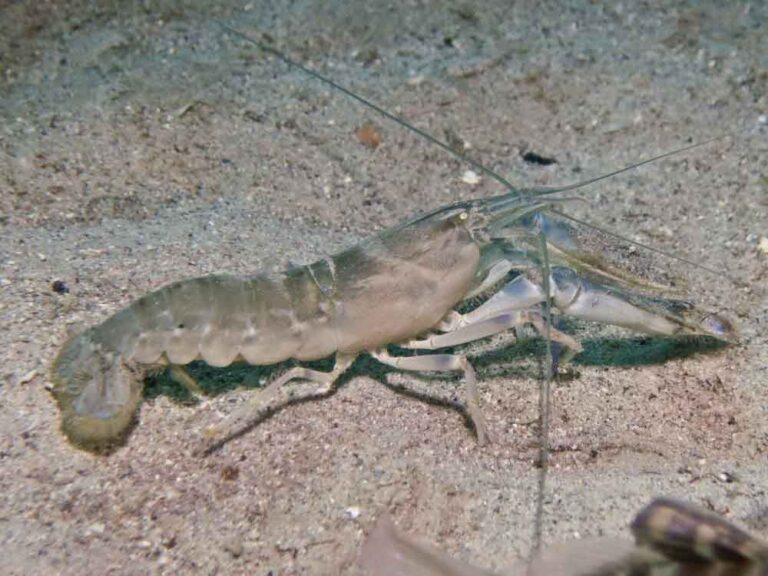
Blue-nipper Snapping Shrimp
Alpheus digitalis complex
undescribed
Description
This is a huge, laterally compressed, heavy-bodied shrimp. Its carapace tapers towards the head.
The carapace is plain grey with a yellowish tinge, darker on the dorsum fading to a light grey on the sides. There may be a Y-shaped dorsolateral marking terminating in the epaulette, but this, if present at all, is very indistinct.
The abdomen is unmarked grey with a matt appearance except where the segments articulate. There is a row of white spots laterally and a distinct black spot on the fourth segment. Like the carapace, the abdomen is darker dorsally.
The rostrum is grey-blue with a yellow-brown fringe. The eyes are white in our photographic images.
The antennae and antennules are yellow-brown.
The pincers, including carpus and merus, are grey-blue becoming dark blue towards the claws. The pollex and dactyl themselves are white and brown. The underside of the pincers is white. The pincers may have a brown fringe.
The chelate second legs are thin, elongated and violet-blue distally. This colour is not unique to this species but is a useful identification feature particularly as they are unusually easy to see in this large, high-standing shrimp.
The walking legs are pale grey with yellow joints.
The tail fan is grey with a pale grey telson and uropods and a yellow fringe. The distal exopod is blue-grey. Setae (hairs) arise primarily from four sites on the uropods, though they may not always be present
Identifying Features
A strikingly large shrimp with blue tips to pincers, overall a pale yellow grey with yellow pleopods. Found in silty habitat, away from the reef.
Similar Shrimps
This large plain-coloured shrimp cannot readily be confused with any other.
Nomenclature
This could possibly correspond to Alpheus digitalis, De Haan, 1844. This was formerly Alpheus distinguendus De Man 1909, it was synonymised by Bruce (1994).
Alpheus digitalis complex has at least two cryptospecies in Japan and two in Thailand (Anker 2001).
Ryanskiy (2016) p7. has images of a similar-looking shrimp and gives the name Alpheus digitalis common name Big Snapping Shrimp. Length up to 9 cm. Distribution Indo-West Pacific – East Africa, Maldives, Japan, Philippines, Indonesia, Papua New Guinea, Australia. Commensal with Vanderhorstia ambanoro.
Called Blue-finger Goby-shrimp, Kuiter and Debelius (2009) but other shrimps also have blue second legs.
Ecology
Habitat
In the Solomon Islands, we found it in a very sheltered lagoon with fine silt and poor visibility between mangroves and a sheltered reef drop-off.
In Queensland, we have only recorded it from the Low Isles, where they live on flat silty sand in a sheltered bay near a mangrove-fringed island.
One of several robust shrimps that account for most of the burrows constructed on the unrelieved fine tenacious silt that covers the bay at low Isles. The others are the Titan Shrimp, the Violet Shrimp and the Tasselled Shrimp.
Preferred substrate
They build their burrows in compacted fine silt with organic debris.
Depth range
5 to 15 metres
Proximity to reef
They live well away from the reef edge.
NATURAL HISTORY
This is a large vigorous shrimp that stirs up a lot of silt when it is working. It builds extensive trenches and open channels extending well out from the entrance of its burrow. The burrow entrance is usually vertical and not reinforced with coral rubble. We usually see these shrimps working in pairs.
Being a very large shrimp it constructs burrows that will accommodate the bigger shrimpgobies but its associations are not restricted to them. There are on the other hand large species such as the giant shrimp goby, Amblyeleotris fontanesii that live in the same area but we have never seen form an association with the Blue Nipper Shrimp although the burrows would be very suitable.
A disorientated shrimp
On one occasion we watched a Smiling Shrimpgoby (Mahidolia mystacina) go for a long walk for no apparent reason while its shrimp, a Blue Nipper Shrimp was making antenna contact. The shrimp followed until a metre away from its burrow. It broke contact when the goby stopped unexpectedly. A short time later the shrimp became disorientated and fled, at increasing speed in the wrong direction. It ran using an unusual posture staying low and close to the ground, until after 5 metres it shot down a random burrow. This was too small for it and it had to force itself in. After a minute a smaller shrimp was ejected from the burrow. It moved to another one. The goby stopped and waited for a minute before returning slowly backwards to the original burrow. We don’t know if they ever became reunited.
Distribution
Published distribution
Indo-West Pacific; East Africa, Maldives, Japan, Philippines, Indonesia, Papua New Guinea and Australia, (Ryanskiy 2016).
Our records
Australia; Low Isles.
Solomon Islands; Ghizo, Kolombangara Island.
Associated Goby species
Associated Shrimpgobies (five species)
Cryptocentrus bulbiceps, Bluelined Shrimpgoby
Cryptocentrus cebuanus, Cebu Shrimpgoby
Cryptocentrus fasciatus, Y-bar Shrimpgoby
Mahidolia mystacina, Smiling Shrimpgoby
Myersina nigrivirgata, Blackline Shrimpgoby

